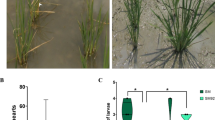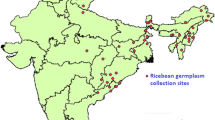Abstract
Key message
FLS is a disease that causes severe yield reduction in soybean. In this study, four genes (Glyma.16G176800, Glyma.16G177300, Glyma.16G177400 and Glyma.16G182300) were tentatively confirmed to play an important role in the resistance of soybean to FLS race 7.
Abstract
Frogeye leaf spot (FLS) causes severe yield loss in soybean and has been found in several countries worldwide. Therefore, it is necessary to select and utilize FLS-resistant varieties for the management of FLS. In the present study, 335 representative soybean materials were assessed for partial resistance to FLS race 7. Quantitative trait nucleotide (QTN) and FLS race 7 candidate genes were identified using genome-wide association analysis (GWAS) based on a site-specific amplified fragment sequencing (SLAF-seq) approach. A total of 23,156 single-nucleotide polymorphisms (SNPs) were used to evaluate the level of linkage disequilibrium with a minor allele frequency ≥ 5 and deletion data < 3%. These SNPs covered about 947.01 MBP, nearly 86.09% of the entire soybean genome. In addition, a compressed mixed linear model was utilized to identify association signals for partial resistance to FLS race 7. A total of 15 QTNs associated with resistance were found to be novel for FLS race 7 resistance. A total of 217 candidate genes located in the 200-kb genomic region of these peak SNPs were identified. Based on gene association analysis, qRT-PCR, haplotype analysis and virus-induced gene silencing (VIGS) systems were used to further verify candidate genes Glyma.16G176800, Glyma.16G177300, Glyma.16G177400 and Glyma.16G182300. This indicates that these four candidate genes may participate in FLS race 7 resistance responses.





Similar content being viewed by others
Data Availability
The datasets generated during and analyzed during the current study are available from the corresponding author on reasonable request.
References
Akem CN, Dashiell KE (1994) Effect of planting date on severity of frogeye leaf spot and grain yield of soybeans. Crop Prot 13:607–610. https://doi.org/10.1016/0261-2194(94)90006-X
Athow KL, Probst AH, Kurtzman CP, Laviolette FA (1952) The inheritance of resistance to frogeye leaf spot of soybean. Phytopathology 42:660–662. https://doi.org/10.1111/j.1399-3054.1952.tb07550.x
Athow KL, Probst AH, Kurtzman CP, Laviolette FA (1962) A newly identified physiological race of Cercospora sojina on Soybean. Phytopathology 52:712–714
Bachman MS, Tamulonis JP, Nickell CD, Bent AF (2001) Molecular markers linked to BrownStem Rot resistance genes, Rbs1 and Rbs2, in soybean. Crop Sci 41:527–535. https://doi.org/10.2135/cropsci2001.412527x
Baker WA, Weaver DB, Qiu JS, Pace PF (1999) Genetic analysis of frogeye leaf spot resistance in PI54610 and Peking soybean. Crop Sci 39:1021–1025. https://doi.org/10.2135/cropsci1999.0011183X003900040010x
Boerma HR, Phillips DV (1983) Genetic implications of the susceptibility of Kent soybean to Cercospora sojina. Phytopathology 74:1666–1668. https://doi.org/10.1094/Phyto-73-1666
Bradbury PJ, Zhang ZW, Kroon DE, Casstevens TM, Ramdoss Y, Buckler ES (2007) TASSEL: software for association mapping of complex traits in diverse samples. Bioinformatics 23:2633–2635. https://doi.org/10.1093/bioinformatics/btm308
Butler S, Kelly H, Mueller T, Kruger G, Cochran A, Raper T (2018) Influence of droplet size and azoxystrobin insensitivity on frogeye leaf spot management in soybean. Crop Prot 112:149–158. https://doi.org/10.1016/j.cropro.2018.05.017
Cheng R, Lim JE, Samocha KE, Sokoloff G, Abney M, Skol AD, Palmer AA (2010) Genome-wide association studies and the problem of relatedness among advanced intercross lines and other highly recombinant populations. Genetics 185:1033–1044. https://doi.org/10.1534/genetics.110.116863
Dashiell KE, Akem CN (1991) Yield losses in soybeans from frogeye leaf spot caused by Cercospora sojina. Crop Prot. https://doi.org/10.1016/S0261-2194(91)80134-2
Gully BS, Shah KR, Lee M, Shearston K, Smith NM, Sadowska A, Blythe AJ, Bernath-Levin K, Stanley WA, Smallb ID, Bonda SC (2014) The design and structural characterization of a synthetic pentatricopeptide repeat protein. Acta Cryst D 71:196–208. https://doi.org/10.1107/S1399004714024869
Han Y, Zhao X, Liu D, Li Y, Lightfoot DA, Yang Z, Zhao L, Zhou G, Wang Z, Huang L, Zhang Z, Qiu L, Zheng H, Li W (2016) Domestication footprints anchor genomic regions of agronomic importance in soybeans. New Phytol 209:871–884. https://doi.org/10.1111/nph.13626
Kim JS, Lee YS, Kim SK, Kim KD, Kim JW (2011) Differential responses of soybean cultivars to Cercospora sojina isolates, the causal agent of frogeye leaf spot in Korea. Plant Pathol J 27(2):183–186. https://doi.org/10.5423/PPJ.2011.27.2.183
Kumagai MH, Donson J, Della-Cioppa G, Harvey D, Hanley K, Grill L (1995) Cytoplasmic inhibition of carotenoid biosynthesis with virus-derived RNA. Proc Natl Acad Sci 92(5):1679–1683. https://doi.org/10.1073/pnas.92.5.1679
Li Z, Wang R, Gao Y, Wang C, Zhao L, Xu N, Chen KE, Qi S, Zhang M, Tsay YF, Crawford NM (2017) The Arabidopsis CPSF30‐L gene plays an essential role in nitrate signaling and regulates the nitrate transceptor gene NRT 1.1. New Phytol 216(4):1205–1222. https://doi.org/10.1111/nph.14743
Lipka AE, Tian F, Wang Q, Peiffer J, Li M, Bradbury PJ, Gore MA, Buckler ES, Zhang Z (2012) Gapit: genome association and prediction integrated tool. Bioinformatics 28:2397–2399. https://doi.org/10.1093/bioinformatics/bts444
Mian MAR, Wang TY, Phillips DV, Alvernaz J, Boerma HR (1999) Molecular mapping of the Rcs3 gene for resistance to frogeye leaf spot in soybean. Crop Sci 39:1687–1691. https://doi.org/10.2135/cropsci1999.3961687x
Mian MAR, Missaoui AM, Walker DR, Phillips DV, Boerma HR (2008) Frogeye leaf spot of soybean: a review and proposed race designations for isolates of Cercospora sojina Hara. Crop Sci 48:14–24. https://doi.org/10.2135/cropsci2007.08.0432
Martin GB, Bogdanove AJ, Sessa G (2003) Understanding the functions of plant disease resistance proteins. Plant Biol 54:23–61. https://doi.org/10.1146/annurev.arplant.54.031902.135035
Missaoui AM, Ha BK, Phillips DV, Boerma HR (2007) Single nucleotide polymorphism detection of the Rcs3 gene for resistance to frogeye leaf spot in soybean. Crop Sci 47:1681–1690. https://doi.org/10.2135/cropsci2006.11.0711
Phillips DV, Boerma HR (1981) Cercospora sojina race 5: a threat to soybean in the southeastern United States. Phytopathology 71:334–336. https://doi.org/10.1094/Phyto-71-334
Phillips DV, Boerma HR (1982) Two genes for resistance to race 5 of Cercospora sojina in soybeans. Phytopathology 72:764–766. https://doi.org/10.1094/Phyto-72-764
Soares APG, Guillin EA, Borges LL, Sliva ACT, Almeida AMR, Grijalba PE, Gottlieb AM, Bluhm BH, Oliveira LO (2015) More Cercospora species infect soybeans across the Americas than meets the eye. PLoS ONE 10(8):e0133495. https://doi.org/10.1371/journal.pone.0133495
Staskawicz B, Dahlbeck D, Keen N, Napoli C (1987) Molecular characterization of cloned avirulence genes fromrace 0 and race 1 of Pseudomonas syringae pv. glycinea. J Bacteriol 169(2):572–578. https://doi.org/10.1128/jb.169.12.5789-5794.1987
Sun XW, Liu DJ, Zhang XF, Li WB, Liu H, Hong WG, Jiang CB, Guan N, Ma C, Zeng HP, Xu CH, Song J, Huang L, Wang CM, Shi JJ, Wang R, Zheng XH, Lu CY, Wang XU, Zheng HK (2013) SLAF-seq: an efficient method of large-scale De Novo SNP discovery and genotyping using high-throughput sequencing. PLoS ONE 8(3):e58700. https://doi.org/10.1371/journal.pone.0058700
Wang JY, Hu ZZ, Zhao T, Yang YW, Chen TZ, Yang ML, Yu WG, Zhang BL (2015) Genome-wide analysis of bHLH transcription factor and involvement in the infection by yellow leaf curl virus in tomato (Solanum lycopersicum). BMC Genomics 16:39. https://doi.org/10.1186/s12864-015-1249-2
Wu XL, Ren CW, Joshi T, Vuong T, Xu D, Nguyen HT (2010) SNP discovery by high-throughput sequencing in soybean. BMC Genomics 11:469. https://doi.org/10.1186/1471-2164-11-469
Yan L, Hofmann N, Li S, Ferreira ME, Song B, Jiang G, Ren S, Quigley C, Fickus E, Cregan P, Song Q (2017) Identification of QTL with large effect on seed weight in a selective population of soybean with genome-wide association and fixation index analyses. BMC Genomics 18(1):529. https://doi.org/10.1186/s12864-017-3922-0
Yang WC, Weaver DB (2001) Resistance to frogeye leaf spot in maturity groups VI and VII of soybean germplasm. Crop Sci 41:549–552. https://doi.org/10.2135/cropsci2001.412549x
Yang W, Weaver DB, Nielsen BL, Qiu J (2001) Molecular mapping of a new gene for resistance to frogeye leaf spot of soya bean in `Peking’. Plant Breed 120:73–78. https://doi.org/10.1046/j.1439-0523.2001.00563.x
Yorinori JT (1992) Management of foliar fungal diseases in Brazil. In: Copping LG, Green MB, Rees RT (eds) Pest management in soybean. Springer, Berlin, pp 185–193
Zhou Y, Xu ZN, Duan CX, Chen YP, Meng QC, Wu JR, Hao ZF, Wang ZH, Li MS, Yong H, Zhang DG, Zhang SH, Weng JF, Li XH (2016) Dual transcriptome analysis reveals insights into the response to rice black-streaked dwarf virus in maize. J Exp Bot 67(15):4593–4609. https://doi.org/10.1093/jxb/erw244
Acknowledgements
We thank LetPub (www.letpub.com) for its linguistic assistance during the preparation of this manuscript.
Funding
This study was conducted in the Key Laboratory of Soybean Biology of the Chinese Education Ministry, Soybean Research & Development Center (CARS) and the Key Laboratory of Northeastern Soybean Biology and Breeding/Genetics of the Chinese Agriculture Ministry, and was financially supported by National Key Research & Development Project (2021YFD1201604), Heilongjiang’s Provincial projects (ZD2022C002, JD22A015), the Chinese National Natural Science Foundation (31971967, U22A20473), the Youth Leading Talent Project of the Ministry of Science and Technology in China (2015RA228), the National Ten-thousand Talents Program, Postdoctoral Fund in Heilongjiang Province (LBH-Q20004) and the National Project (CARS-04-PS06).
Author information
Authors and Affiliations
Contributions
YPH and XZ conceived the study. CN and HRM were responsible for methodology. HLL, SCL, JHZ and YMY contributed to software. CN and HPJ carried out the formal analysis. XZ and YGL conducted investigation. YPH was involved in resources. CN, HRM and YHZ curated the data. CN, HPJ and XZ participated in writing—original draft preparation. XZ and YPH took part in writing—review and editing. WLT and YPH performed the supervision. WLT, YPH and YGL acquired the funding. All authors read and approved the manuscript.
Corresponding authors
Ethics declarations
Conflict of interest
The authors declare that they have no conflict of interest.
Ethics approval
The authors have adhered to the ethical responsibilities outlined by Theoretical and Applied Genetics.
Consent to participate
Informed consent was obtained from all individual participants included in the study.
Consent to publish
The authors affirm that research participants provided informed consent for publication of the images and tables.
Additional information
Communicated by Dechun Wang.
Publisher's Note
Springer Nature remains neutral with regard to jurisdictional claims in published maps and institutional affiliations.
Supplementary Information
Below is the link to the electronic supplementary material.
Rights and permissions
Springer Nature or its licensor (e.g. a society or other partner) holds exclusive rights to this article under a publishing agreement with the author(s) or other rightsholder(s); author self-archiving of the accepted manuscript version of this article is solely governed by the terms of such publishing agreement and applicable law.
About this article
Cite this article
Na, C., Miao, H., Jiang, H. et al. Genome-wide association analysis of resistance to frogeye leaf spot China race 7 in soybean based on high-throughput sequencing. Theor Appl Genet 136, 119 (2023). https://doi.org/10.1007/s00122-023-04359-1
Received:
Accepted:
Published:
DOI: https://doi.org/10.1007/s00122-023-04359-1




